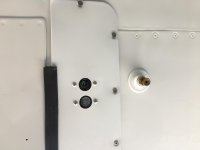Tumper
Well Known Member
Hey friends,
Years ago, I effectively lost the vision in one eye, so I fly with monocular vision. I completed my RV-9 about 8 years ago and have been flying it since then.
When getting my tailwheel endorsement, I was “trained” to do a three-point landing. However, I was never quite able to master it. My problem is judging the height above the ground. I blame (right or wrong) my inability to judge my height above the ground on monocular vision, i.e. limited depth perception.
Right now, I always do wheel landings. I jokingly say I land by braille. When I feel the ground, push forward a little and cut power. However, I would like to have the option of doing a three point.
Here is my question. Does anyone have a ground proximity warning device on their plane? I looked for one for small GA planes, but I didn’t find anything. I know they must be out there.
A lot of cars have warning systems for backing up. And there are plenty out there to add to a car that didn’t have it factory installed. Would it work for an airplane?
I searched the forum and didn’t find anything on the subject.
Also, please don’t bash my landing skills unless you have monocular vision.
Years ago, I effectively lost the vision in one eye, so I fly with monocular vision. I completed my RV-9 about 8 years ago and have been flying it since then.
When getting my tailwheel endorsement, I was “trained” to do a three-point landing. However, I was never quite able to master it. My problem is judging the height above the ground. I blame (right or wrong) my inability to judge my height above the ground on monocular vision, i.e. limited depth perception.
Right now, I always do wheel landings. I jokingly say I land by braille. When I feel the ground, push forward a little and cut power. However, I would like to have the option of doing a three point.
Here is my question. Does anyone have a ground proximity warning device on their plane? I looked for one for small GA planes, but I didn’t find anything. I know they must be out there.
A lot of cars have warning systems for backing up. And there are plenty out there to add to a car that didn’t have it factory installed. Would it work for an airplane?
I searched the forum and didn’t find anything on the subject.
Also, please don’t bash my landing skills unless you have monocular vision.





